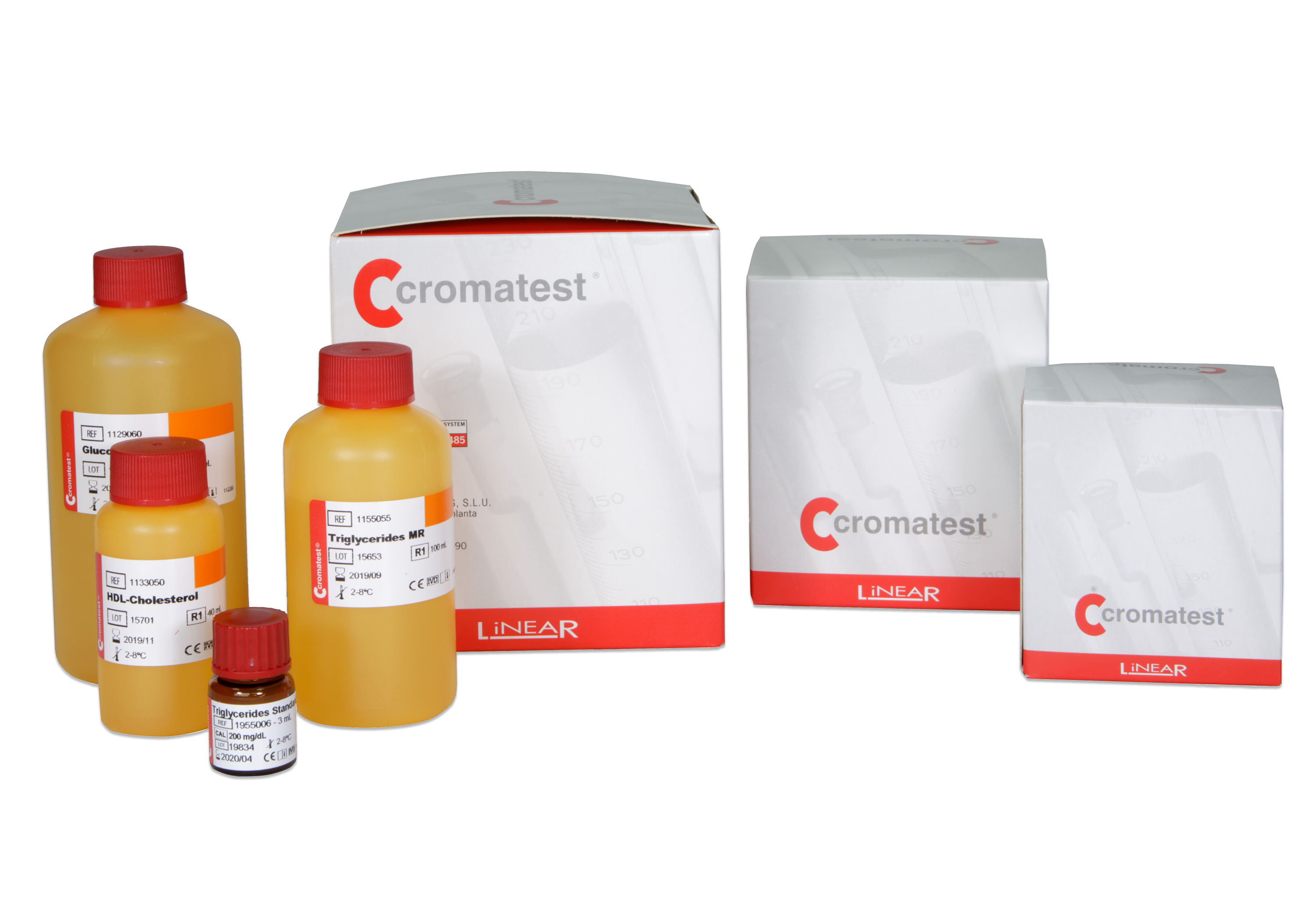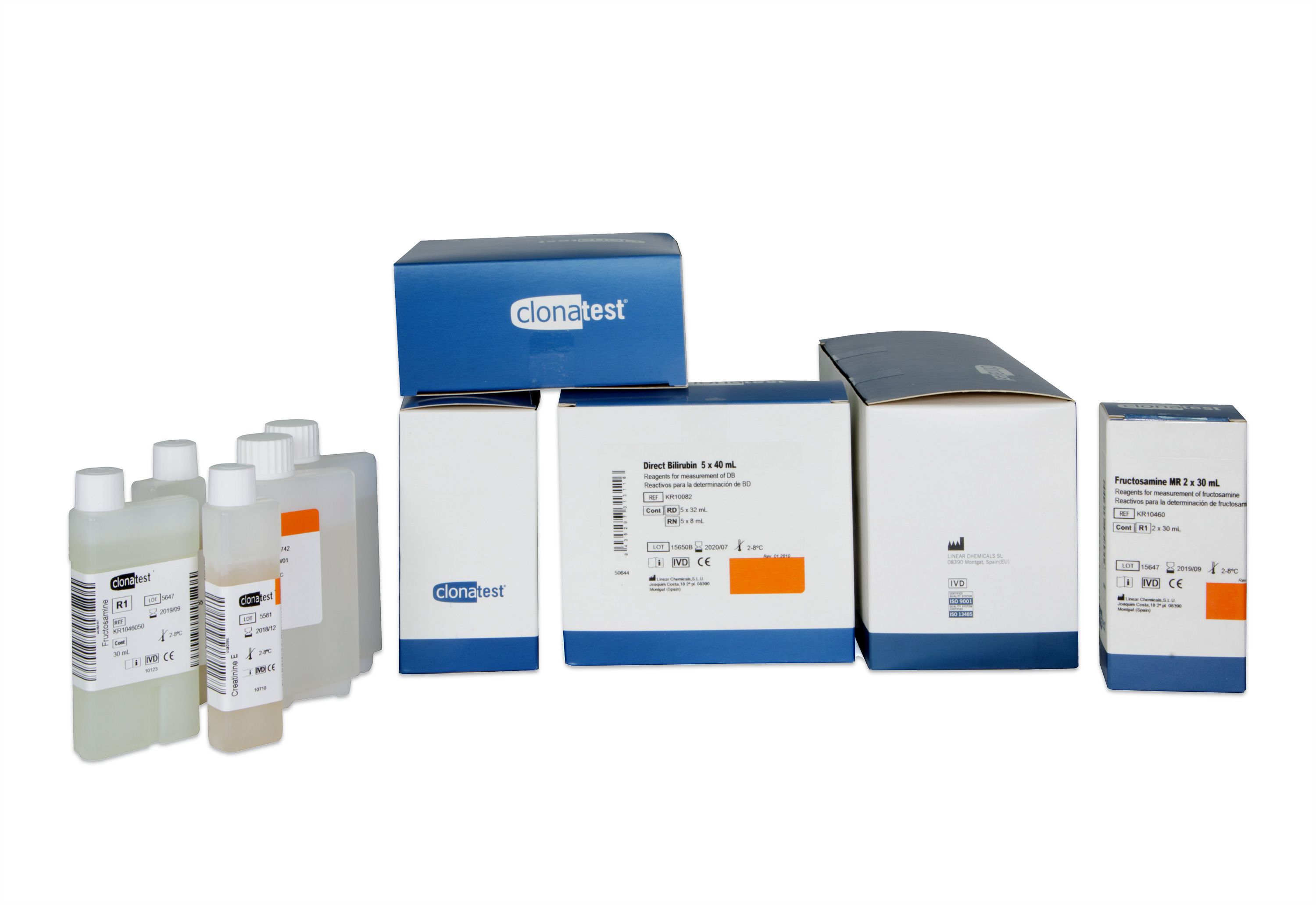

Cromatest
378 results
-

Urea Berthelot 4x100 ml
1156015Urea is hydrolysed by urease into ammonia and carbon dioxide. The ammonia generated reacts in an alkaline medium with hypochlorite and sodium salicylate in the presence of nitroprusside, a precursor agent of a green chromophore whose intensity is proportional to the concentration of urea in the sample.
-

Urea/BUN BR 2x50 ml
1158005Urea is hydrolysed by urease to ammonia and carbon dioxide. Ammonia is converted to glutamate by glutamate dehydrogenase (GlDH) in the presence of NADH and ketoglutarate. The reaction is measured kinetically at 340 nm through the decrease in absorbance resulting from the oxidation of NADH to NAD+, proportional to the concentration of urea present in the sample.
-

Urea/BUN BR 3x100 ml
1158010Urea is hydrolysed by urease to ammonia and carbon dioxide. Ammonia is converted to glutamate by glutamate dehydrogenase (GlDH) in the presence of NADH and ketoglutarate. The reaction is measured kinetically at 340 nm through the decrease in absorbance resulting from the oxidation of NADH to NAD+, proportional to the concentration of urea present in the sample.
-

Potassium 3x50 ml
1150010Reagent for the in vitro quantitative determination of potassium in human serum for the control of electrolyte balance in the diagnosis and treatment of diseases characterized by high or low blood potassium levels. Potassium is determined spectrophotometrically by kinetic assay using potassium-dependent pyruvate kinase. The generated pyruvate is converted into lactate present in the conversion of NADH to NAD. The corresponding decrease in optical density at 380 nm is proportional to the potassium concentration in the serum.
-

Potassium 1x40 ml
KR10330Reagent for the in vitro quantitative determination of potassium in human serum for the control of electrolyte balance in the diagnosis and treatment of diseases characterized by high or low blood potassium levels. Potassium is determined spectrophotometrically by kinetic assay using potassium-dependent pyruvate kinase. The generated pyruvate is converted into lactate present in the conversion of NADH to NAD. The corresponding decrease in optical density at 380 nm is proportional to the potassium concentration in the serum.
-

Potassium 1x50 ml
CT10330Reagent for the in vitro quantitative determination of potassium in human serum for the control of electrolyte balance in the diagnosis and treatment of diseases characterized by high or low blood potassium levels. Potassium is determined spectrophotometrically by kinetic assay using potassium-dependent pyruvate kinase. The generated pyruvate is converted into lactate present in the conversion of NADH to NAD. The corresponding decrease in optical density at 380 nm is proportional to the potassium concentration in the serum.
-

Sodium 1x30 ml
1151015Reagent for the in vitro quantitative determination of sodium in human serum for the control of electrolyte balance in the diagnosis and treatment of diseases characterized by high or low blood sodium levels. Sodium is determined through the sodium-dependent b-galactosidase enzymatic activity with ONPG as a substrate. The absorbance at 405 nm of the O-nitrophenyl product is proportional to the sodium concentration.
-

Sodium 2x60 ml
1151010Reagent for the in vitro quantitative determination of sodium in human serum for the control of electrolyte balance in the diagnosis and treatment of diseases characterized by high or low blood sodium levels. Sodium is determined through the sodium-dependent b-galactosidase enzymatic activity with ONPG as a substrate. The absorbance at 405 nm of the O-nitrophenyl product is proportional to the sodium concentration.
-

Sodium 1x40 ml
KR10340Reagent for the in vitro quantitative determination of sodium in human serum for the control of electrolyte balance in the diagnosis and treatment of diseases characterized by high or low blood sodium levels. Sodium is determined through the sodium-dependent b-galactosidase enzymatic activity with ONPG as a substrate. The absorbance at 405 nm of the O-nitrophenyl product is proportional to the sodium concentration.
-

Sodium 1x30 ml
CT10340Reagent for the in vitro quantitative determination of sodium in human serum for the control of electrolyte balance in the diagnosis and treatment of diseases characterized by high or low blood sodium levels. Sodium is determined through the sodium-dependent b-galactosidase enzymatic activity with ONPG as a substrate. The absorbance at 405 nm of the O-nitrophenyl product is proportional to the sodium concentration.
-

Total Protein 2x50 ml
1153005En la reacción del biuret se forma un quelato entre el ión Cu2+ y los enlaces peptídicos de las proteínas en medio alcalino con la formación de un complejo coloreado violeta cuya absorbancia se mide fotométricamente. La intensidad del color producido es proporcional a la concentración de proteínas en la muestra.
-

LDH BR 3x50 ml
CT10282